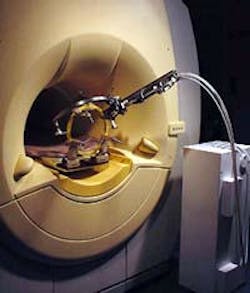
A team of European academics and vendors is collaborating on a multilaser system that can nonthermally treat and remove deep-seated brain tumors and treat functional diseases such as Parkinson's. Designed and constructed by MRC Systems (Heidelberg, Germany) and being clinically tested at the University of Cologne (Cologne, Germany), the system combines stereotactic navigation with picosecond-laser, plasma-induced ablation to precisely destroy tumors and other unwanted tissue without damaging surrounding healthy tissue.
Other laser-based systems have been developed for neurosurgery; however, like many laser applications, these systems have relied on thermal ablation to achieve tissue and tumor destruction. The major disadvantage of these thermal-based systems is that the heat from the laser can diffuse into surrounding healthy tissue, causing unwanted damage. In addition, while the tumor tissue is destroyed it is not removed, and this necrotic tissue can have a toxic effect in the brain.
The patented MRC tumor treatment system uses a multiphase, lithotripsy-like approach to overcome these drawbacks. In addition to the picosecond surgical laser (an 8-W modelocked amplified Nd:YAG laser with a 4-kHz repetition rate and 2 mJ/s pulse rate), the system includes:
- laser probe (three titanium tubes movable against each other with an outer diameter of 5.5 mm and a length of 140 mm)
- coagulation laser (continuous-wave Nd:YAG (28 W) for coagulation (only for tumor surgery)
- a modelocked amplified Nd:vandate laser (1-kHz rep rate, 1 mJ/s pulse, 1-W average power) for therapy of functional diseases
- pressure-controlled suction device
- integrated microscope
- therapy-planning software
- magnetic resonance imaging integration components (see figure).
In preclinical tumor-ablation trials at the University of Cologne under the direction of Dr. V. Sturm, head of the clinics for stereotactic and functional neurosurgery, the stereotactic laser probe was used to focus the picosecond laser pulses directly into tumors in dogs. The outer tube of the probe is advanced to the focal spot; during ablation, the inner tube of the laser probe rotates. Using computer-controlled scanning of multiple laser pulses, the ablation volume can be arranged in any target shape. The surgeon defines the target volume in arbitrary slices of computed tomography and MR images and determines optimal access to the tumor. Ablation contours are converted into an optimized laser ablation strategy. By gradually advancing the probe and adjusting the distance of the focal spot from the laser probe, the entire tumor is dismantled piece by piece. The multiple laser pulses fragment the tumor into tiny particles that can then be removed with the integrated irrigation and aspiration system equipped with a pressure sensor to monitor intracranial pressure.
At the same time, an integrated laser-scanner-microscope detects critical structures such as blood vessels to avoid intracranial bleeding. The blood vessels must not be ablated, but cauterized using the coagulation laser, which is also guided through the probe. The laser-scanner microscope is also equipped with tumor markers that can be used for fluorescence spectroscopy to detect tumor cells as well. Future system designs are expected to integrate alternative monitoring tools, such as transcranial ultrasound sonography.
The design and development of this complex surgical system has been funded and supported by EU biomedicine and health project BMH4-CT96-0716, "Demonstration and clinical test of an MR-compatible stereotactic probe for laser-neurosurgery with real-time imaging." The final product design is expected to be complete by year's end, with human trials slated to begin shortly after that. Ongoing animal trials are focusing on both functional neurosurgery for Parkinson's disease and tumor treatment.
MRC expects to obtain the European CE mark and begin marketing the system in Europe and other countries once the first human trials are completed. The company has no plans at this time to market the system in the United States, according to Marcus Goetz, MRC project manager. In addition to MRC and the University of Cologne, other partners involved in this project include University Hospital Gasthuisberg (Leuven, Belgium), SL Microtest Wissenschaftliche Gerate (Jena, Germany), German Center for Cancer Research (Heidelberg), University of Heidelberg Institute for Applied Physics, Institute of Quantum Electronics (Zurich, Switzerland), and Time-Bandwidth Products (Zurich).
Kathy Kincade | Contributing Editor
Kathy Kincade is the founding editor of BioOptics World and a veteran reporter on optical technologies for biomedicine. She also served as the editor-in-chief of DrBicuspid.com, a web portal for dental professionals.